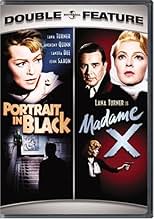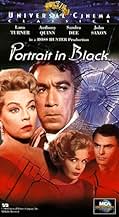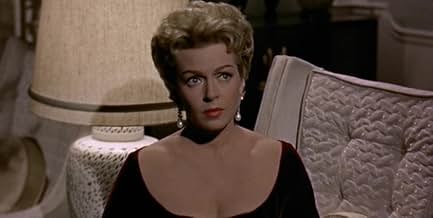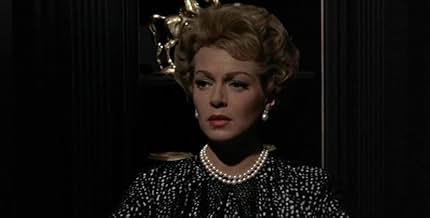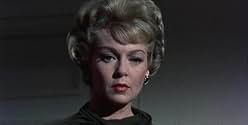IMDb-BEWERTUNG
6,3/10
1992
IHRE BEWERTUNG
Nachdem eine verheiratete Frau und ihr Liebhaber ihren grausamen Ehemann ermordet haben, geraten sie ins Visier von jemandem, der von ihrem Verbrechen weiß.Nachdem eine verheiratete Frau und ihr Liebhaber ihren grausamen Ehemann ermordet haben, geraten sie ins Visier von jemandem, der von ihrem Verbrechen weiß.Nachdem eine verheiratete Frau und ihr Liebhaber ihren grausamen Ehemann ermordet haben, geraten sie ins Visier von jemandem, der von ihrem Verbrechen weiß.
Empfohlene Bewertungen
A beautiful, but faithless woman(Lana Turner) plots with her handsome, but brooding doctor-lover(Anthony Quinn) to murder her sickly husband(Lloyd Nolan). No, there's nothing overly fancy about this suspense melodrama, in fact in content it's quite ordinary. But the movie is given Hollywood's full treatment with striking photography, splendid costuming and decor, and good performances by a capable cast. Trivia: this film reunited IMITATION OF LIFE producer Ross Hunter with that movie's stars Lana Turner and Sandra Dee. Having played mother and daughter in that film, Turner and Dee are stepmother and stepdaughter this time around.
Portrait in Black (1960)
In a beautifully drippy, bleeding, sticky Douglas Sirk mode, and one year after leading lady Lana Turner appeared in Sirk's "Imitation of Life," this highly slick and artificial (and yet moving) melodrama is one of the high points in a low period of Hollywood. The other main character is Anthony Quinn, who is remarkable, too, one of those underrated leading men, I'm not sure why. The two of them are supported by Richard Basehart as a fascinating and chilling underling with a peculiar mysterious cheerfulness, and Sandra Dee, who plays the spoiled daughter all too well (as you can imagine).
Unlike Sirk's dramas, this one, directed by is not just about normal human dramas (soap opera stuff), but adds a criminal and suspense element that kicks in after half an hour. The throbbing music takes on a different meaning here, and the sobbing and regrets make for an intense ride.
The deeper you get into this movie, the deeper the plot gets, with intrigue and worry and more murder mounting. And it's all filmed with fluid, rich, widescreen color photography, with intensely rendered music (that holds nothing back), and with a subtle kind of attention to nuance that oddly adds to the excesses of the plot.
And it's the plot, the story, that is so finely tuned it sustains all this cinematic swaying. It's not like some movies where the music or the photography drives the plot--here they are woven together really well, artfully and emphatically. Quinn and Turner are both extraordinary, lifting what could have been a soap opera to something completely fuller.
Russell Metty, behind the camera, was at the peak of his career, having shot not only "Imitation of Life" the year before but Sirk's early "Written on the Wind" (and moving on quickly to several masterpieces like "Spartacus" and "The Misfits"). And in fact the composer, veteran Frank Skinner, wrote the music for those two classic Sirk films, as well. It's worth stressing all this because Sirk has a huge (and deserved) following, and I have a feeling this one is just under the radar of Sirk fans. If a great Sirk film seems to almost reference itself the way it becomes so perfectly "arch" in its stereotypes, "Portrait in Black" does maintain a sense of being still a film wanting to move a plot idea along (these are subtle differences about style becoming affectation on purpose). But even so, the parallels are extraordinary, and this is a remarkable movie on those terms.
It's worth wondering what else, beyond Sirk, was going on around this time, and in fact, with the murder and suspense here it helps to look at Hitchcock's films "North by Northwest" (1959) and "Vertigo" (1958). Both are clearly influences in filming style, lacking only that higher level of stylized artfulness (and storytelling) that Hitch was by then such a master of. Or then, you might say, there was perhaps the influence of Sirk on Hitchcock, at least in the visual richness and fluidity (something Hitch abandoned immediately, almost making a point, this very year with "Psycho").
Anyway, if you don't mind an over the top melodrama done to perfection, here you go. And for movie fans, check out Anna May Wong's last film appearance (not a great performance, but she's her own legend). See it on the biggest screen you can, too--this doesn't translate well at all to a laptop experience.
In a beautifully drippy, bleeding, sticky Douglas Sirk mode, and one year after leading lady Lana Turner appeared in Sirk's "Imitation of Life," this highly slick and artificial (and yet moving) melodrama is one of the high points in a low period of Hollywood. The other main character is Anthony Quinn, who is remarkable, too, one of those underrated leading men, I'm not sure why. The two of them are supported by Richard Basehart as a fascinating and chilling underling with a peculiar mysterious cheerfulness, and Sandra Dee, who plays the spoiled daughter all too well (as you can imagine).
Unlike Sirk's dramas, this one, directed by is not just about normal human dramas (soap opera stuff), but adds a criminal and suspense element that kicks in after half an hour. The throbbing music takes on a different meaning here, and the sobbing and regrets make for an intense ride.
The deeper you get into this movie, the deeper the plot gets, with intrigue and worry and more murder mounting. And it's all filmed with fluid, rich, widescreen color photography, with intensely rendered music (that holds nothing back), and with a subtle kind of attention to nuance that oddly adds to the excesses of the plot.
And it's the plot, the story, that is so finely tuned it sustains all this cinematic swaying. It's not like some movies where the music or the photography drives the plot--here they are woven together really well, artfully and emphatically. Quinn and Turner are both extraordinary, lifting what could have been a soap opera to something completely fuller.
Russell Metty, behind the camera, was at the peak of his career, having shot not only "Imitation of Life" the year before but Sirk's early "Written on the Wind" (and moving on quickly to several masterpieces like "Spartacus" and "The Misfits"). And in fact the composer, veteran Frank Skinner, wrote the music for those two classic Sirk films, as well. It's worth stressing all this because Sirk has a huge (and deserved) following, and I have a feeling this one is just under the radar of Sirk fans. If a great Sirk film seems to almost reference itself the way it becomes so perfectly "arch" in its stereotypes, "Portrait in Black" does maintain a sense of being still a film wanting to move a plot idea along (these are subtle differences about style becoming affectation on purpose). But even so, the parallels are extraordinary, and this is a remarkable movie on those terms.
It's worth wondering what else, beyond Sirk, was going on around this time, and in fact, with the murder and suspense here it helps to look at Hitchcock's films "North by Northwest" (1959) and "Vertigo" (1958). Both are clearly influences in filming style, lacking only that higher level of stylized artfulness (and storytelling) that Hitch was by then such a master of. Or then, you might say, there was perhaps the influence of Sirk on Hitchcock, at least in the visual richness and fluidity (something Hitch abandoned immediately, almost making a point, this very year with "Psycho").
Anyway, if you don't mind an over the top melodrama done to perfection, here you go. And for movie fans, check out Anna May Wong's last film appearance (not a great performance, but she's her own legend). See it on the biggest screen you can, too--this doesn't translate well at all to a laptop experience.
Adultery, murder, blackmail, and Lana Turner, what more could one ask of a Ross Hunter production? Perhaps a good script, but that would spoil the fun. "Portrait in Black" will have lovers of camp in stitches at dialog that makes daytime soaps seem Shakespearean. The overwrought emoting and melodramatic scenes are often unintentionally funny, and the plot requires Olympian leaps to cross the credibility gaps.
Lana is having an affair with Anthony Quinn, the doctor who is attending her terminally ill husband, Lloyd Nolan, a shipping magnate. Nolan's company, Cabot Lines, is evidently quite successful, because Lana's daily expenditures on wardrobe, coiffures, and makeup would likely sink a ship. The couple's palatial San Francisco home is a Ross Hunter fantasy whose upkeep could sink yet another Cabot Line vessel. Nolan's daughter from a first marriage, Sandra Dee, evidently has her stepmother's taste in clothes and manicure, while the son from his marriage to Lana has to make do with a toy airplane. Throw in a greedy business associate played by Richard Basehart; Dee's suitor, John Saxon; a chauffeur, Ray Walston; and a housekeeper, Anna May Wong; and you have a delicious cast of potential suspects to populate an Agatha Christie mystery. However, "Portrait in Black" is not a whodunit, but rather a "who knows they dun it."
Lana is the ultimate drama queen, and she is in peak form. She suffers, she screams, she cries; she is the empress of high camp. Anthony Quinn, who should have read the script before he signed the contract, plays down to his part and seems to know he has had and will have better parts. Sandra Dee appears to be studying for future Lana Turner roles, while Walston and Wong play their parts with the necessary ambiguity to keep viewers guessing their secrets.
However, despite the overacting, bad writing, and soap opera direction, "Portrait in Black" is great fun for those who love their melodramas with big budgets and great style. Even the obligatory mirror smashing has been incorporated. The movie is enormously entertaining for its sometimes howlingly funny situations, absurd lines, and the sheer pleasure of watching Lana looking and emoting at her best.
Lana is having an affair with Anthony Quinn, the doctor who is attending her terminally ill husband, Lloyd Nolan, a shipping magnate. Nolan's company, Cabot Lines, is evidently quite successful, because Lana's daily expenditures on wardrobe, coiffures, and makeup would likely sink a ship. The couple's palatial San Francisco home is a Ross Hunter fantasy whose upkeep could sink yet another Cabot Line vessel. Nolan's daughter from a first marriage, Sandra Dee, evidently has her stepmother's taste in clothes and manicure, while the son from his marriage to Lana has to make do with a toy airplane. Throw in a greedy business associate played by Richard Basehart; Dee's suitor, John Saxon; a chauffeur, Ray Walston; and a housekeeper, Anna May Wong; and you have a delicious cast of potential suspects to populate an Agatha Christie mystery. However, "Portrait in Black" is not a whodunit, but rather a "who knows they dun it."
Lana is the ultimate drama queen, and she is in peak form. She suffers, she screams, she cries; she is the empress of high camp. Anthony Quinn, who should have read the script before he signed the contract, plays down to his part and seems to know he has had and will have better parts. Sandra Dee appears to be studying for future Lana Turner roles, while Walston and Wong play their parts with the necessary ambiguity to keep viewers guessing their secrets.
However, despite the overacting, bad writing, and soap opera direction, "Portrait in Black" is great fun for those who love their melodramas with big budgets and great style. Even the obligatory mirror smashing has been incorporated. The movie is enormously entertaining for its sometimes howlingly funny situations, absurd lines, and the sheer pleasure of watching Lana looking and emoting at her best.
Lana Turner plays Sheila Cabot. She's unhappily married to a mean, old and rich man who treats her like that. She's having a secret affair with his doctor (Anthony Quinn). They plan and inject a lethal air bubble into her husband killing him. She gets all his money. They think they've gotten away with it till Turner receives a note in the mail saying, "Congratulations on the success of your murder". Who knows it and what do they want. A young Sandra Dee and John Saxon are mixed up in this.
The plot is OK, it LOOKS great and Turner is always dressed to the 9s but this fails utterly. It has terrible dialogue--truly laughable. The acting doesn't help, Turner--a wonderful actress--gives a lousy performance. Quinn is seriously miscast and out of his depth. Saxon and Dee are good but are hardly in it. There's also a totally ridiculous but fun plot twist at the end. This was (understandably) a box office failure but is now considered a camp classic. Proceed at your own risk.
The plot is OK, it LOOKS great and Turner is always dressed to the 9s but this fails utterly. It has terrible dialogue--truly laughable. The acting doesn't help, Turner--a wonderful actress--gives a lousy performance. Quinn is seriously miscast and out of his depth. Saxon and Dee are good but are hardly in it. There's also a totally ridiculous but fun plot twist at the end. This was (understandably) a box office failure but is now considered a camp classic. Proceed at your own risk.
This film was released 40 years ago yet stands the test of time.The music,costumes and sets are excellent, the acting lovable melodrama and the real winner... in my view.... the lighting!
Can you get an Oscar for that??
The tale is of a repressed rich housewife conspiring with her doctor lover to rid them of her invalid husband......and the spiders web which flows from that....
Great acting from all the cast---do not miss it!
Can you get an Oscar for that??
The tale is of a repressed rich housewife conspiring with her doctor lover to rid them of her invalid husband......and the spiders web which flows from that....
Great acting from all the cast---do not miss it!
Wusstest du schon
- WissenswertesFinal film of Anna May Wong.
- PatzerAlthough Mason is shown driving a 1959 Dodge Custom Royal Lancer, the car that goes over the cliff is a less expensive 1958 Dodge Coronet Lancer. And, when it goes over the cliff, extensive front-end damage can be seen, meaning this was probably a wrecked car the studio purchased just for this scene.
- Zitate
Sheila Cabot: Oh don't leave me David, please don't go away!
Dr. David Rivera: I've got to go!
Sheila Cabot: But why Darling, why? I don't know what I'll do if you go!
Dr. David Rivera: I'm - I'm afraid of what I'll do if I stay!
- VerbindungenEdited into The Green Fog (2017)
Top-Auswahl
Melde dich zum Bewerten an und greife auf die Watchlist für personalisierte Empfehlungen zu.
Details
- Erscheinungsdatum
- Herkunftsland
- Sprache
- Auch bekannt als
- Portrait in Black
- Drehorte
- San Francisco, Kalifornien, USA(sequence at Devil's Slide on the Pacific Coast Highway - State Route 1)
- Produktionsfirma
- Weitere beteiligte Unternehmen bei IMDbPro anzeigen
Box Office
- Budget
- 1.400.000 $ (geschätzt)
- Laufzeit
- 1 Std. 52 Min.(112 min)
Zu dieser Seite beitragen
Bearbeitung vorschlagen oder fehlenden Inhalt hinzufügen



